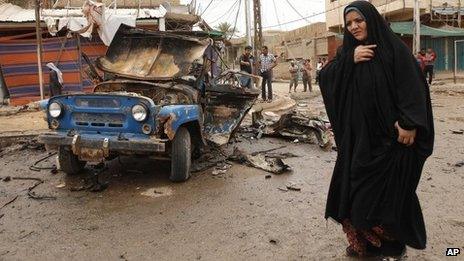Iraq study estimates war-related deaths at 461,000
- Published

The study says more than 60% of deaths were directly attributable to violence
About half a million people died in Iraq as a result of war-related causes between the US-led invasion in 2003 and mid-2011, an academic study suggests.
University researchers from the US, Canada and Iraq based their estimate on randomised surveys of 2,000 households, external.
The toll includes not only violent deaths from the invasion and subsequent insurgency, but avoidable fatalities linked to infrastructure collapse.
It exceeds the 112,000 violent civilian deaths reported by Iraq Body Count, external.
The British-based organisation bases its tally on media reports, hospital and mortuary records, and information from official and non-governmental sources.
There has been a surge in sectarian violence in Iraq in the past year, with almost 5,000 civilians killed in attacks between January and September, according the UN. It says more than 3,000 people died in 2012.
'Compromised' infrastructure
The study - by researchers from the University of Washington, Johns Hopkins University, Simon Fraser University and Mustansiriya University - covers March 2003 until June 2011, six months before the US withdrawal.
For it, interviewers surveyed 2,000 randomly selected households in 100 geographical clusters across Iraq's 18 provinces between May 2011 and July 2011. Each was asked about deaths among household members and siblings from 2001, when Iraq's infrastructure was already degrading because of international sanctions, to the time of the interview.
From that, the researchers found the "wartime crude death rate" was 4.55 per 1,000 people, more than 50% higher than before the invasion.
By multiplying those rates by the annual Iraq population, the researchers estimated that the "total excess deaths attributable to the war" up until mid-2011 to be about 405,000.
They also estimated that an additional 56,000 deaths were not counted because of the emigration of households from Iraq.
The study concludes that more than 60% of the estimated 461,000 excess deaths were directly attributable to violence, with the rest associated with the collapse of infrastructure and other indirect causes. These include the failures of health, sanitation, transportation, communication and other systems.
The most common causes of non-violent deaths linked to the war were heart attacks or cardiovascular conditions, followed by infant or childhood deaths other than injuries, chronic illnesses and cancer.
5 live's Shelagh Fogarty speaks with Nickolay Mladenov and Dr Mowaffak Al Rubaie
"In a war situation, people can't leave their homes to get medical care. When they do leave their homes to get medical care, they arrive at institutions overwhelmed with violent injuries," Amy Hagopian, associate professor of Global Health at the University of Washington and lead author of the paper, told NBC News, external.
"The water is compromised. Stress is elevated. The power is out. The distribution networks for medical supplies are compromised."
The researchers warn that their estimates are associated with "substantial uncertainties". Their estimated death toll was extrapolated from a small representative sample of households, and respondents were asked to recall events that occurred up to 10 years earlier. They also had to rely on outdated census data from 1987 for their population figures.